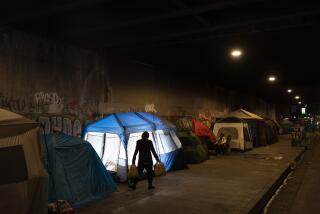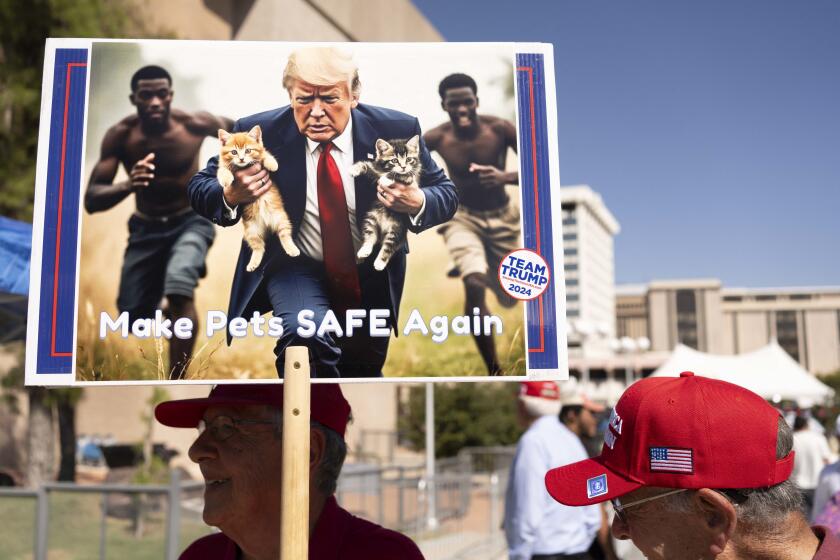The gang’s all here
When my wife and I and our two small children moved late last year to Glassell Park, a neighborhood in northeast Los Angeles, we were following a predictable gentrification script. The nearby enclaves of Eagle Rock and Mount Washington were slightly out of our price range, having already attracted those who had been edged out of the previous round of gentrification in Silver Lake, Echo Park and Franklin Hills.
We picked the area both for its leafy, hilly landscape and the lovely three bedrooms/two bath homes you don’t have to manage a hedge fund or direct a blockbuster to afford. Following the basic logic of contemporary urban real estate, we expected to reap modest rewards for investing in an area that had suffered modest neglect.
FOR THE RECORD:
Gang name: An article in Sunday’s Opinion pages mistakenly referred to the Mongols gang as the Mogols. —
We hadn’t counted on two forces able to resist this logic: the major recession centered on the housing market; and the Avenues gang.
The Avenues appeared first. Prior to moving into our charming little Cal-Mediterranean house, I’d never heard of them. But this insular band of remorselessly violent folk has ruled their Eastside turf since before the Dodgers came to town. The dream of gentrification doesn’t always include perfect research, and when I called the Los Angeles Police Department to ask about the safety of our new neighborhood, the voice at the other end of the line assured me that “it’s pretty quiet up there.” The Avenues got left out.
In truth, it seems that for the most part they keep to themselves, in the flatter regions of Glassell Park on the other side of the Glendale Freeway from our house. I say for the most part because our arrival roughly coincided with the midday gun battle between gang members and the LAPD in February that brought three helicopters and a SWAT team to the neighborhood. Several schools were forced to evacuate, and the authorities put an entire swath of the city on lockdown to search for suspects.
As the choppers’ drone took over, we kept stepping out to our yard to gaze up. They seemed just a football field away in the sky. The ink was barely dry on the escrow papers and I was already locking my doors and thinking about asking my brother the cop to recommend a good home-defense sidearm.
Four months later, 500 federal agents, including 10 SWAT teams, swept into the neighborhood, attempting a shock-and-awe crackdown, complete with a racketeering indictment and the arrest of 28 gang members. It seems that the Avenues had been engaged in a violent turf war with the nearby Cypress Park gang. (We hadn’t heard of them, either.) The U.S. district attorney sounded upbeat when he said that this action would succeed where all previous efforts had failed. I hated to doubt him, but it was hard to feel reassured. Nothing kills the gentrifying buzz quite like a lucrative drug trade, turf war and the backing of the Mexican mafia.
Besides, who was to say that shutting the Avenues down wouldn’t simply allow the Cypress Park gang to move northward? And these weren’t the only tough customers operating in our budding gentrifiers’ paradise. The next time we had helicopters hovering overhead, it was some of the colorful meth-dealing Mogols motorcycle gang getting busted.
Even the most optimistic participants in gentrification culture find living in the middle of an organized-crime enclave tricky. All anyone really wants to talk about is whether the new restaurant on Eagle Rock Boulevard is any good, or which microbrews are on tap at the pub on York. We’re all looking for routes around the fear that, if accepted, could overpower all dreams about life in a new house.
How do civilians manage such proximity to hard-core organized crime? At my house, we make jokes. Our first strategy was to “Soprano”-ize the situation.
So if the local Fresh & Easy market discontinues an item, it must be because the Avenues weren’t cool with it. That taco truck of such consistent excellence? It must function as the Avenues’ Satriale’s Pork Store. We modify lines from “The Godfather.” “Leave the AK-47. Take the churro.” Uneasy chuckles ensue.
It looks as if we’ll be adopting this pose for a while to come, particularly because the plunge in home values has compelled us to stick to our urban revival plans even as our quality-of-life aspirations appear undermined. Most of us are smart enough to connect rising unemployment statistics to the very real possibility that our gang problems may get worse before they get better. And if the economy stays stalled, will the cafes and art galleries stick around?
Gentrification is often an early casualty of recessions, as is the general sense that once-troubled neighborhoods will forever improve under the influence of easy home-equity loans and the plucky resolve of middle-class urban pioneers. It’s an illusion, this mythology of continual redemption.
That becomes clear when the bottom falls out and the bad guys reassert themselves. Big cities are full of pockets of trouble. Some longtime residents of gentrifying neighborhoods aren’t with the program, either, especially if their livelihood isn’t exactly above board.
There’s mild bravery in attempting gentrification, as well as a reversal of what many of us consider to be a grave past injustice. Those who abandoned the cities in the 1960s and ‘70s were unapologetic about their motives. For them, the cities were going rapidly to hell, and they were going to put some distance between themselves and the threat.
Generation gentrification, by contrast, is attempting to rehabilitate menace by living with it. To be sure, we genuinely desired a more urban life and more diverse neighborhoods; and if we were honest, we would also recognize how far violent crime rates have fallen in the last 30 years. We figured we could neuter any remaining danger by exposing it to the irresistible pressure of our Starbucks-y values system.
But what we were also doing was rolling the dice -- gambling that the truly bad economic times would stay at bay long enough for our chosen neighborhoods to improve. At that point, we’d have the option to move on.
Your average gang member may enjoy a low-fat vente soy latte just as much as that refugee from the overpriced Westside. I don’t know. But it’s foolhardy to assume that once the sushi and eyewear boutiques arrive, a gang like the Avenues will fold up and slink off to more overtly scary precincts, even as more affluent residents demand police and political attention. The gangs have their own ambitions, and zealously protecting what’s always been theirs is high on the list. What are cool T-shirt emporia in the face of reliable drug profits defended by assault weapons?
If history is any guide, the recession will eventually end and the gentrification of the Eastside will resume apace. But even then, the neighborhood will remain home to both the likes of us and the Avenues. Humor helps us live together, but deep down, we don’t think they’re funny at all.
Matthew DeBord is a writer in Los Angeles.
More to Read
A cure for the common opinion
Get thought-provoking perspectives with our weekly newsletter.
You may occasionally receive promotional content from the Los Angeles Times.










